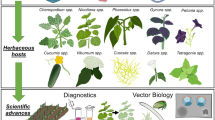
Overview
- High readability of the text, logical presentation, careful choice of language, and inclusion of color pictures on symptoms exhibited by infections and diseases caused by different viruses
- The book is comprehensive and contains all aspects of grapevine virology and most up to date information
- The editorial team comprises of leading scientists in the field. Each of the chapters is written by leading experts on the specific subject area in question
- There are no competitive books in this scale that is currently available. This is the first edition of a quality and comprehensive book that will be made available on grape viruses and their diseases, diagnostics, virus transmission as well as control and management measures
Access this book
Tax calculation will be finalised at checkout
Other ways to access
About this book
The domestication of grapes dates back five thousand years ago and has spread to nearly all continents. In recent years, grape acreage has increased dramatically in new regions, including the United States of America, Chile, Asia (China and India), and Turkey. A major limiting factor to the sustained production of premium grapes and wines is infections by viruses. The advent of powerful molecular and metagenomics technologies, such as molecular cloning and next generation sequencing, allowed the discovery of new viruses from grapes. To date, grapevine is susceptible to 64 viruses that belong to highly diverse taxonomic groups. The most damaging diseases include: (1) infectious degeneration; (2) leafroll disease complex; and (3) rugose wood complex. Recently, two new disease syndromes have been recognized: Syrah decline and red blotch. Losses due to fanleaf degeneration are estimated at $1 billion annually in France alone. Other diseases including leafroll, rugose wood, Syrah de
cline and red blotch can result in total crop loss several years post-infection. This situation is further exacerbated by mixed infections with multiple viruses and other biotic as well as adverse abiotic environmental conditions, such as drought and winter damage, causing even greater destruction. The book builds upon the last handbook (written over twenty years ago) on the part of diagnostics and extensively expands its scope by inclusion of molecular biology aspects of select viruses that are widespread and economically most important. This includes most current information on the biology, transmission, genome replication, transcription, subcellular localization, as well as virus-host interactions. It also touches on several novel areas of scientific inquiry. It also contains suggested directions for future research in the field of grapevine virology.Similar content being viewed by others
Keywords
Table of contents (33 chapters)
-
Front Matter
-
An Overview on Grapevine Viruses, Viroids and the Diseases They Cause
-
Front Matter
-
Reviews
Editors and Affiliations
About the editors
Prof. Deborah A. Golino, University of California, Foundation Plant Services, Davis, CA 95616-8751, USA
Assoc.Prof. Marc Fuchs, Department of Plant Pathology, and Plant-Microbe Interactions, Cornell University, Ithaca,
NY 14853-5905, USA
Bibliographic Information
Book Title: Grapevine Viruses: Molecular Biology, Diagnostics and Management
Editors: Baozhong Meng, Giovanni P. Martelli, Deborah A. Golino, Marc Fuchs
DOI: https://doi.org/10.1007/978-3-319-57706-7
Publisher: Springer Cham
eBook Packages: Biomedical and Life Sciences, Biomedical and Life Sciences (R0)
Copyright Information: Springer International Publishing AG 2017
Hardcover ISBN: 978-3-319-57704-3Published: 18 July 2017
Softcover ISBN: 978-3-319-86229-3Published: 12 August 2018
eBook ISBN: 978-3-319-57706-7Published: 05 July 2017
Edition Number: 1
Number of Pages: XI, 698
Number of Illustrations: 16 b/w illustrations, 76 illustrations in colour
Topics: Plant Pathology, Agriculture, Microbiology



